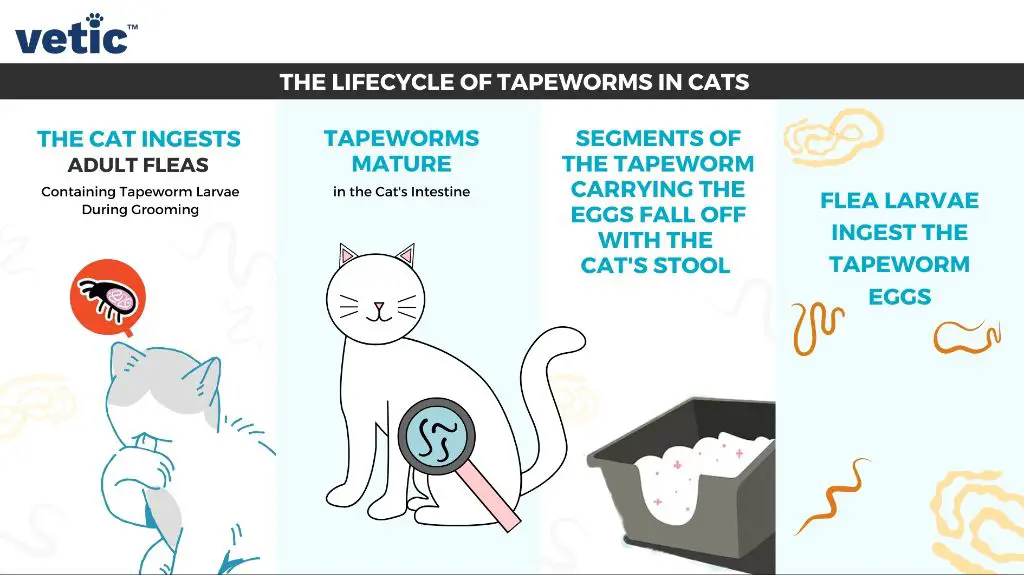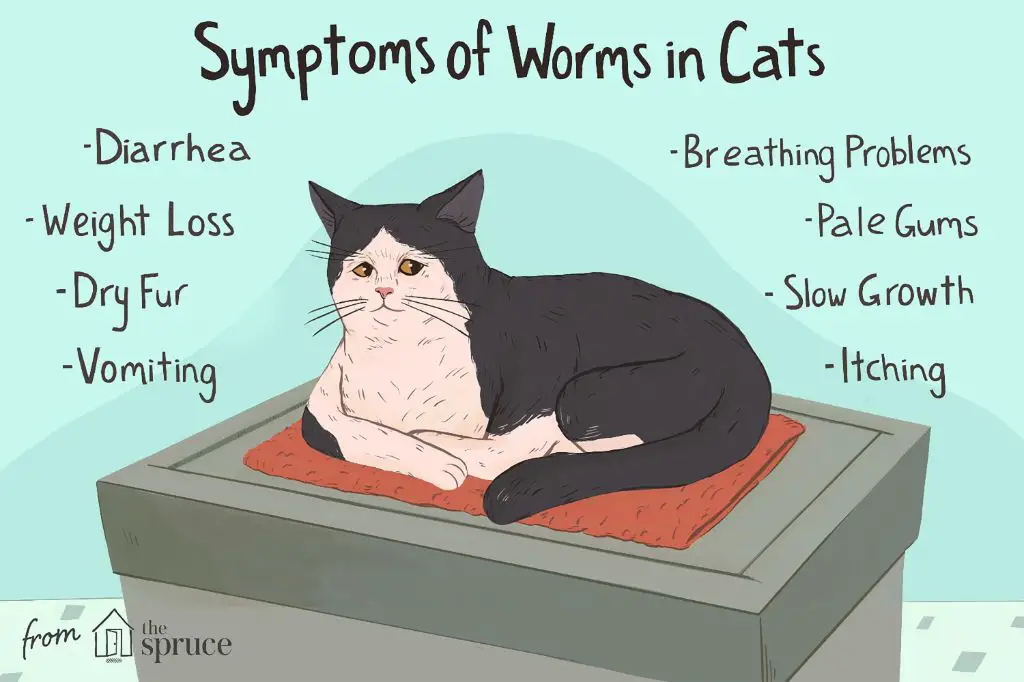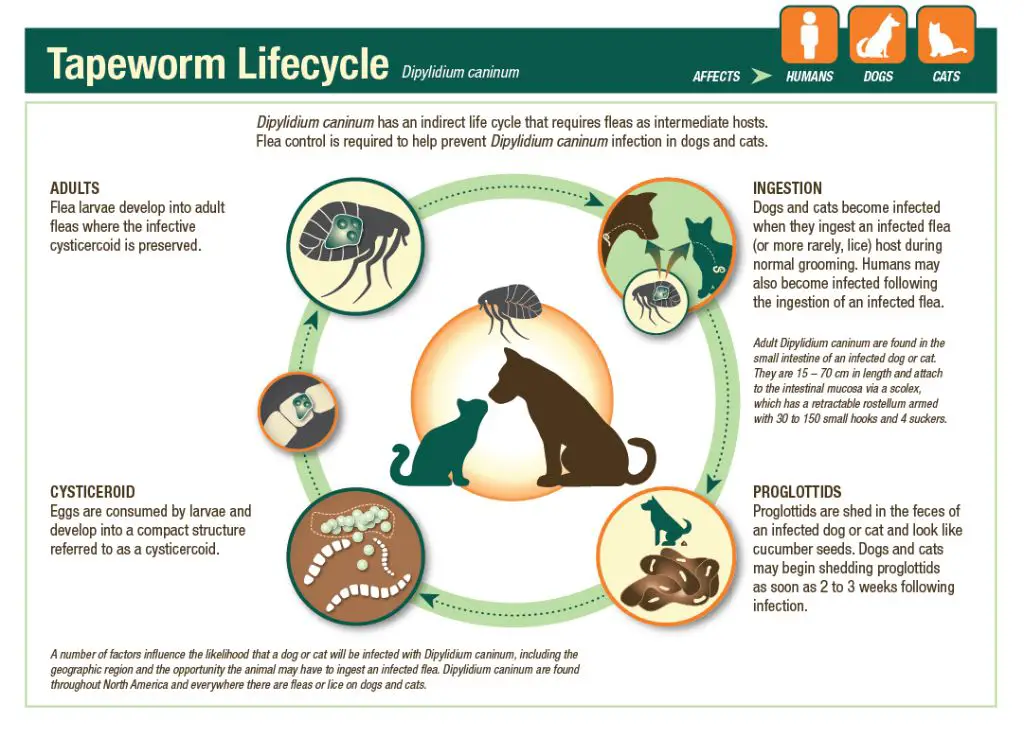What are Cat Tapeworms?
Cat tapeworms are intestinal parasites that live in the small intestine of cats. The scientific name for the most common tapeworm in cats is Dipylidium caninum. Tapeworms can grow to be over 6 inches long and attach themselves to the intestinal lining with hook-like mouthparts (Source).
Cats become infected with tapeworms when they ingest infected fleas during grooming. The immature form of the tapeworm lives inside the flea. When the cat eats the flea, the tapeworm is released into the cat’s intestine where it matures into an adult worm (Source).
Common symptoms of tapeworm infection in cats include:
- Segments of the tapeworm passed in the cat’s feces or stuck to fur around the anus
- Scooting or dragging rear along the ground
- Licking or chewing at the anus
- Visible tapeworm segments around anus that look like rice grains or cucumber seeds
- Weight loss
- Dull coat
Are Tapeworms Dangerous for Cats?

Tapeworms are usually not life threatening for cats, but they can cause some health issues if left untreated (VCahospitals.com). While a light tapeworm infection often produces no symptoms, heavy infestations may result in digestive upset, weight loss, and a dull, dry coat in cats. This is because tapeworms live in the intestines and consume nutrients from the cat’s diet, depriving the cat of vital nutrients for growth and health. Tapeworm segments that pass out in the feces can also cause irritation around the anus. Overall, while tapeworms are generally not dangerous for cats, heavy infestations can negatively impact a cat’s health and comfort. Monitoring cats for symptoms and treating infections promptly can help minimize any risks or discomfort from tapeworms.
Can Humans Get Cat Tapeworms?
Yes, humans can get tapeworms from cats, but it’s not very common. According to the CDC, Dipylidium tapeworm infection in humans is rare but possible if a person accidentally swallows an infected flea [1]. Tapeworm eggs are carried by fleas. When a cat ingests an infected flea while grooming itself, the tapeworm larvae hatch inside the cat’s intestine and grow into adult tapeworms. If an infected flea makes its way into a human’s mouth and is swallowed, the tapeworm larvae can hatch and develop into an intestinal infection.
Symptoms of tapeworm infection in humans may include [2]:
- Abdominal pain
- Nausea
- Diarrhea
- Itching around the anus
- Weight loss
However, many tapeworm infections cause no symptoms at all. The infection is typically diagnosed by finding tapeworm segments or eggs in a stool sample. Tapeworms in humans are treatable with prescription anti-parasitic medications.
Diagnosing Tapeworms in Cats

There are a few ways veterinarians can diagnose tapeworm infections in cats:
Observing rice-like proglottid segments around the cat’s anus or in its feces. These small, rice-like particles contain tapeworm eggs and can sometimes be seen crawling near the anus. According to VCA Hospitals, “Most commonly, an owner recognizes that their cat has tapeworms through the observation of proglottids on feces or in vomit”[1].
Microscopic examination of the cat’s feces to look for tapeworm eggs. The eggs may not always be shed consistently, so multiple fecal samples may need to be examined over time.
Tape test: A clear piece of tape can be pressed to the cat’s anus to pick up eggs. The tape is then examined under a microscope for tapeworm eggs.
In some cases, an ELISA blood test may also be used to detect tapeworm antigens in the cat’s bloodstream.
Treating Cat Tapeworms
The most common treatment for tapeworms in cats is oral deworming medication prescribed by a veterinarian. Medications like praziquantel or epsiprantel are highly effective at killing tapeworms. The vet will determine the appropriate dosage and number of doses based on the cat’s weight and severity of infestation. Typically, tapeworms can be eliminated with just one or two doses of dewormer.
It’s also important to treat the cat concurrently for fleas, since tapeworms use fleas as an intermediate host. Effective flea control is essential to breaking the tapeworm life cycle and preventing reinfection. This may involve prescription flea medication from the vet in addition to thorough cleaning of the home environment.
With prompt veterinary treatment, most cats are cured of a tapeworm infection within 1-2 weeks. A follow up fecal test may be recommended to confirm the tapeworms have been fully eliminated. If any eggs remain after treatment, additional medication may be prescribed. Overall, tapeworms are very responsive to oral deworming medications when combined with diligent flea control.
Sources:
https://www.petco.com/shop/en/petcostore/product/bayer-tapeworm-dewormer-tablets-for-cats
https://www.amazon.com/Elanco-Tapeworm-Dewormer-praziquantel-tablets/dp/B019CD4ZDS
Preventing Cat Tapeworms
Preventing tapeworm infections in cats starts with effective flea control and prevention.

Fleas are a common intermediate host that transmit tapeworm eggs and larvae to cats. Using monthly topical flea preventatives like Nexgard can stop the tapeworm life cycle by killing fleas before they can ingest tapeworm eggs. Vacuuming areas frequented by cats and washing pet bedding regularly also helps control flea infestations.
Keeping litter boxes clean is another way to prevent tapeworms. Scoop solid waste from litter boxes daily and empty litter every 1-2 weeks. Then fully wash the litter box with soap and hot water to remove any remaining parasite eggs. Replace old litter with fresh, clean litter.
Since tapeworm eggs can spread through contact, be sure to wash hands thoroughly after interacting with an infected cat. Teach children proper hygiene after touching pets. Promptly clean up any feces in shared areas to prevent environmental contamination.
Other prevention tips include keeping cats indoors so they avoid ingesting rodents or other prey. Controlling rodent populations around the home can also lower tapeworm transmission risks for outdoor cats who hunt.
Environmental Control
Environmental control is a critical part of preventing and eliminating tapeworm infections in cats. Tapeworm eggs can survive in the environment for months to years if conditions are right, so proper sanitation and containment measures are essential. Vacuuming carpets, furniture, cat beds, and anywhere the cat spends time can help remove any tapeworm eggs. It’s recommended to vacuum daily in high traffic areas when trying to control an infection. The vacuum bag should be disposed of after each use to prevent recontamination. Additionally, bedding like blankets, pillows, cushions etc. should be washed at least weekly in hot water and detergent and dried on a high heat setting.

Disinfecting the home and yard can also help destroy any tapeworm eggs. A diluted bleach solution or commercial disinfectant safe for pets should be used to wipe down any hard surfaces the cat has access to. When possible, litter boxes should be emptied daily and the entire box disinfected weekly. Backyards, gardens, sandboxes and any outdoor areas the cat frequents should also be kept clean and free of cat feces through daily scooping and biweekly disinfecting.
Covering any outdoor sandboxes when not in use can help prevent access by neighborhood cats or wild animals that may contaminate the area. Indoor litter boxes should be placed in an area inaccessible to young children who may put contaminated sand or litter in their mouth. With diligent environmental control, the number of tapeworm eggs in the home and yard can be substantially decreased.
Prognosis for Cat Tapeworms
With prompt diagnosis and appropriate treatment, the prognosis for tapeworm infection in cats is excellent https://vcahospitals.com/know-your-pet/tapeworm-infection-in-cats. The tapeworms can be fully eliminated from the cat’s intestinal tract using an effective deworming medication prescribed by a veterinarian.
However, reinfection is common if fleas are not properly controlled, since fleas are a key part of the tapeworm lifecycle https://www.petmd.com/cat/conditions/infectious-parasitic/c_ct_cestodiasis. Tapeworm eggs are passed in the proglottids that detach from the adult tapeworms in an infected cat’s intestine. These proglottids release eggs into the environment, which are then ingested by flea larvae. The lifecycle continues when the infected flea larvae mature into fleas that can transmit the tapeworm infection to cats or dogs.
For these reasons, completely eliminating a tapeworm infection can be challenging. Preventing reinfection requires diligent flea control and repeat deworming to break the tapeworm lifecycle. With consistent prevention and treatment, tapeworms can be well-managed in households with infected cats.
Managing an Infected Cat
If your cat has been diagnosed with tapeworms, there are some steps you should take to properly manage the infection at home:
First, it’s a good idea to isolate the infected cat from any other household pets initially. Tapeworm eggs and segments can spread easily between animals, so keeping the infected cat separated will help prevent transmission. Provide the cat with its own litter box, food and water dishes, bedding, and toys.
Be sure to promptly clean up and disinfect any vomit or feces that may contain tapeworm eggs. Use gloves when handling contaminated items and dispose of them in a sealed plastic bag. Clean the area thoroughly with hot soapy water, followed by disinfectant. Steam cleaning carpets can help kill any eggs.
Monitor your cat’s appetite and energy levels closely. Some cats may experience reduced appetite, lethargy, or stomach upset as a result of the infection. If symptoms persist more than a day or two after starting treatment, contact your vet.
Follow all medication and treatment instructions from your vet carefully. Completing the full course of deworming medication is essential to fully eliminating the tapeworm infection.
Restrict access of the infected cat to areas where small rodents or fleas may be present until the infection has cleared. This will help prevent reinfection.
With proper treatment and management at home, most cats make a full recovery from tapeworms. Just be sure to keep up with regular deworming to prevent a recurrence in the future.
When to See a Vet
Cat owners should bring their cat to a vet if tapeworm segments are seen around the anus or in the cat’s bedding. Segments may look like rice grains or sesame seeds and indicate an active tapeworm infection. A vet can provide a prescription dewormer to effectively kill the tapeworms.
It’s also a good idea to bring a cat to the vet for an initial tapeworm diagnosis. The vet will check for tapeworm segments around the anus and may collect a fecal sample to test for tapeworm eggs under a microscope. Getting an accurate diagnosis from the vet is important before beginning treatment.
Additionally, cat owners should schedule a vet visit if the cat seems unwell or shows any signs of illness beyond the presence of tapeworms. Symptoms like vomiting, diarrhea, weight loss or lethargy may indicate a more serious health issue that requires veterinary attention (VCAAnimalHospitals.com).
While over-the-counter dewormers may claim effectiveness against tapeworms, visiting a vet for prescription medication often leads to the best results. The vet can recommend the proper medication type, dosage and treatment schedule to fully eliminate the tapeworm infection.

